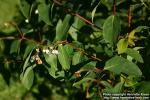
 Related entry: Apocynum (U. S. P.)—Apocynum
Related entry: Apocynum (U. S. P.)—Apocynum
The root of Apocynum androsaemifolium, Linné, gathered in autumn after the leaves and fruit have matured.
Nat. Ord.—Apocynaceae.
COMMON NAMES: Dog's bane, Indian hemp, Bitter root.
ILLUSTRATIONS.—Bot. Mag., 280; Rigel's Med., 36; Amer. Disp., 8th ed., Pl. 3.
Botanical Source, History, and Description.—Apocynum androsaemifolium has a close resemblance to A. cannabinum, but is found in more northern latitudes, being the more common species in Canada and in the Northeastern States. The leaves are oval, roundish, about three-fourths as wide as they are long, and end in short, mucronate points. They are smooth, of lighter color on the under surface, and are attached to the stem at nearly a right angle, on leaf-stalks about 1/4 of an inch in length. The flowers are larger than in Apocynum cannabinum, and are disposed in loose, terminal panicled cymes, extending beyond the leaves. The corolla is flesh-colored, with spreading lobes, and more than twice the length of the calyx. Our illustration was drawn from a plant furnished by Mr. F. H. Hosford. The root of this plant is rarely found in market. It bears a general resemblance to that of Apocynum cannabinum, although its distinguishing characteristics are well marked, and sufficiently distinct to forbid confusion, and to prevent substitutions from being practiced upon those who have compared the two roots. Apocynum androsaemifolium has a long running root. When dry, it is contorted, frequently having the woody remains of its stalks attached. It is shriveled longitudinally, and often marked by transverse fractures, that extend through the bark and show the white woody center. Occasionally the bark scales off. The root breaks with difficulty, its central part being woody. Externally, the bark is dark-brown, white upon its inner surface, and readily separates from the central or ligneous part of the root; it is very bitter. The central part of the root is smooth and firm, bends before breaking, and usually requires considerable twisting before the woody fibers give way. Attached to the root are rootlets, not very plentiful, which bear a general resemblance to the main root, their central portion being woody and covered by a brown epidermis. The confusion that has existed regarding the roots of Apocynum androsaemifolium and Apocynum cannabinum results from the general resemblance of the plants, and from the fact that the names bitter root and Indian hemp have been applied indiscriminately to both species by herb gatherers and country people. A. cannabinum is quite plentiful in localities from which our (Cincinnati) market is supplied, while the A. androsaemifolium is scarce. This plant, likewise called Dog's bane, Milkweed, etc., is found growing in dry, sandy soils, and in the borders of woods from Maine to Florida, flowering from May to August; when any part of it is wounded, a milky juice exudes. The large, milky root is the medicinal portion, or rather its bark, which forms the greater part of it; it possesses an unpleasant, amarous taste. It yields its properties to alcohol, but especially to water. Age impairs its virtues.
Chemical Composition.—Zollickoffer states that it contains resin, caoutchouc, and mucus. Bigelow supposed it to contain volatile oil, soluble red coloring matter, extractive, and a body resembling caoutchouc. The bitter principle has been isolated as a semi-solid mass, and is thought to contain apocynin, and the glucoside, apocyneïn (see Apocynum).
Action, Medical Uses, and Dosage.—Emetic, diaphoretic, tonic, and laxative. When given with capsicum or opium its emetic action is checked, and with the latter drug diaphoresis is produced. It has been found very valuable in the treatment of chronic hepatic affections, and in conjuction with menispermum in dyspepsia and amenorrhoea. When it is required to promptly empty the stomach, without causing much nausea, or a relaxed condition of the muscular system, the powdered root may be given in doses of 40 to 60 grains. However, it is said to occasion a subsequent weakness or languor, from which the patient is some time in recovering. As a laxative, it is useful in cases of constipation, and in hepatic derangements. As a tonic, 10 or 20 grains may be given to stimulate the digestive apparatus, and thus effect a corresponding impression on the general system. As a diaphoretic it must be combined with opium, in the proportion of 1 grain of the latter to 40 of the former, and divided into three or four doses; however, as a diaphoretic it is inferior. Also reputed useful as an alterative in rheumatism, scrofula, and syphilis, having been much used in the first and last complaint by the American Indians. Its chief use, however, is in dyspepsia with constipation, and in headache with torpor of the bowels, as well as in nervous headache and headache due to sluggish venous capillary circulation of the brain. It is somewhat singular that it does not meet dropsical conditions like its relative, Apocynum cannabinum. Dose: Infusion (℥j to water Oj), 1 fluid drachm to 1 fluid ounce; fluid extract, 1 to 20 drops: tincture, 1 to 30 drops every 3 hours.

